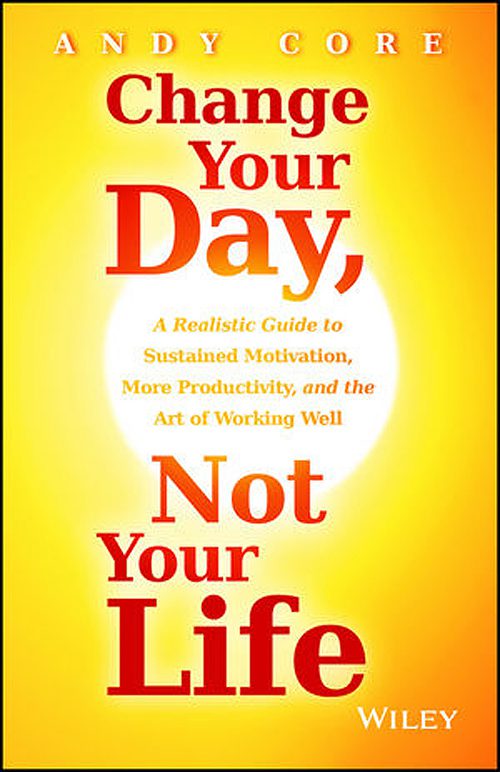
There are few things as satisfying as checking things off of a “To-Do List,” especially when it comes to work projects. To author Andy Core, having a manageable list takes you from out of control and into a new position: CEO of your life.

But being a CEO comes with stress, Core notes. And that can make you feel like a hot mess. It can feel like the dreams you once had – of leading your department, being the top salesperson, joining the C-suite – have disappeared into the quicksand that has become your daily life.
“As you go through life, you develop habits and routines that you think will help you succeed,” says Core, author of the new book “Change Your Day, Not Your Life: A Realistic Guide to Sustained Motivation, More Productivity, and the Art of Working Well” (Wiley, 2014).
“Problem is, many of those patterns probably don’t work for you personally. What’s productive for your coworker may not work well for you, for example. Or a strategy that was effective five years ago may no longer work,” Core says.
Even your instincts can lead you astray, he says. But you can change habits and patterns that don’t serve you. You can refocus your attention, redirect your thoughts, and generate greater motivation, energy, optimism, and creativity, as well as more rewarding relationships.
A credentialed, award-winning thought leader on increasing employee engagement, Core is the perfect coach to help you become what he calls a “Thriver”: someone who works hard, meets or exceeds expectations, and enjoys high levels of personal and professional success, accompanied by (and this is the best part) lower stress levels.
“To start reclaiming the goals that once inspired and excited you, you’ll have to change the way you approach your day,” says Core. “Instead of a worker whose actions are dictated by supervisors and to-do lists, you’ll need to begin acting like the CEO of your own life.”
 Read on for a few CEO-worthy tactics that will help you start thriving immediately:
Read on for a few CEO-worthy tactics that will help you start thriving immediately:
Figure out what’s doable in a day. You may need to re-engineer your routine a little bit at a time, one day at a time, cutting out a small stressor here, and adding in a more productive habit there. The whole strategy is to make small, doable changes that would, over time, create an unstoppable momentum.
“You must do the same,” Core adds. “You must set realistic boundaries. You must create goals that can be accomplished in the space of a day. Remember, nearly all problems, challenges, and needs are best faced if they are brought down to the scale of ‘what can be done right now’ by taking on ‘one small piece’ of a difficult situation.”
Get big things done before 9 a.m. (instead of snoozing, procrastinating, and lurking at the water cooler). Ever notice how your morning sets the tone for your whole day? As Sir Isaac Newton famously said, “Objects in motion tend to stay in motion.” So if an object (you) gets a groggy, frustrating start, you’ll probably feel sluggish and behind the eight-ball all day long. However, if you start your day with positive and productive ideas, actions, thoughts, and feelings, you’re likely to gain momentum throughout the day.
DO first, then KNOW (not the other way around). Most people believe that the knowledge that something is important should make you want to do it. But in reality, that’s not the case. So, why don’t we do what we know we should do? If we know spending less time on Facebook will make us more productive, why won’t we just commit to spending an hour less on the site each day? If we know setting aside 30 minutes to walk or jog each day will make us healthier, why aren’t we jumping up off the couch right now?
“Study after study shows that knowledge alone usually isn’t enough to impact our desires,” Core shares. “In fact, the opposite is true. First, you must do something—like bite the bullet and put on your workout clothes! If you experience positive feelings, attitudes, and results because of your action, you will learn that whatever you just did is good, and you’ll want to do it again, and again, and again. Over time, you’ll develop a new habit, and you’ll become an evolved person.”
Own up to your junk hours. “Junk hours” are a little like junk food: While they provide short-term pleasure, they contribute to long-term imbalance and exhaustion. For instance, junk hours might include chasing rabbit trails on the Internet, shooting the breeze with colleagues at the water cooler, checking email in order to avoid doing other work, or even attending an unnecessary meeting.
“In order to maximize each day, you need to own up to your junk hours,” Core says. “You need to identify when you’re going through the motions of work, versus when real work is being done. Don’t be ashamed that your junk hours exist, because everybody needs to take breaks and shift gears. Your task now is to exchange your low-value ‘junk’ activities for ones that build greater health and value into your workday.”
Instead of adding to your to-do list, build a new pattern. Maybe you’re thinking, Sure, I’d like to change my day, but the thought of adding a boatload of items to my already out-of-control to-do list makes me want to crawl back into bed. If that sounds familiar, take a deep breath. The changes that build momentum are rooted in decisions, not additional tasks.
“To build a productive new pattern into your life, you usually won’t have to add new tasks to your day,” Core says. “Instead, you’ll simply do what you are already doing, or want to do, in a way that becomes habitual. For instance, if you want to wake up an hour earlier so that you can jump-start the day, you simply have to change the time your alarm rings and the time you go to bed. If you want to be more productive at work, you might have to replace aimless procrastination with scheduled breaks. In both cases, you’re changing the way you perform existing tasks, not adding new ones.”
Make a big-box checklist. It’s a given that you have a to-do list. Maybe it’s on paper, on your smartphone, or just in your head…but you have one. It’s also highly likely that your list isn’t as useful as it could be. Too often, you get stuck doing the urgent instead of the important. Core has a solution: Make an actual, on-paper checklist each afternoon for the following day or each morning. Put a box by each task—the more important that task is for you to complete that day, the bigger its box should be.
“I focus first on my big-box tasks,” Core explains. “At the end of the day, if most of them have checkmarks, it’s generally been a good day! Yes, prioritizing my daily list by the size of the boxes on it may sound simplistic, but it has made me feel much more accomplished and satisfied with my day. It also has helped me relax in the evenings because it is easier to remember the big boxes I’ve checked off, thereby making it easier to leave work at work. I’m no longer distracted by each shiny ball that rolls by—I’m able to ignore them and train my focus on what’s really important.”
Think about it so you don’t have to think about it. We all have “those” tasks and obligations that eat up a lot of our time, that we find difficult and frustrating, or both. For instance, when you come home at the end of each day, maybe you find yourself standing in the middle of your kitchen with no clue what to cook for dinner. Core recalls that as a hunt-and-peck typist, he was once slowed down and aggravated by the need to produce papers and reports.
“Figure out where these areas are for you and commit to learning a new pattern,” he says. “For me, that meant buying a book and relearning how to type using a two-hand method. In the cooking example above, that might mean getting into the habit of planning meals and shopping for their ingredients each weekend. Yes, learning new patterns can initially be tedious and laborious. But once they’ve taken hold—often in three weeks or less—they’ll speed up your performance, streamline your effort, and lower your stress. By putting in some thought about ‘problem areas’ now, you’ll save yourself from having to think about them later. Eventually, this method changes once-tedious tasks into automatic, ‘I don’t have to think about it’ behaviors.”



